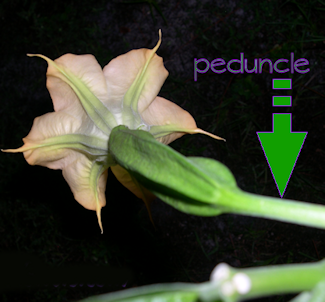Plant Glossary of
Terms
P
Plant Glossary P
Panicle: 1. (Life Sciences & Allied Applications / Botany) a compound raceme, occurring esp in grasses 2. (Life Sciences & Allied Applications / Botany) any branched inflorescence
[from Latin panicula tuft, diminutive of panus thread, ultimately from Greek penos web; related to penion bobbin] panicled adj
Parafilm: A stretchable, breathable, easily cut adhesive tape used to seal culture containers, it is readily available from scientific supply companies
Parenchyma: A large, thin walled cell that has the capacity to regenerate and differentiate. Theya re the most common type of plant cell
Parent Plant: A plant that is used to produce other plants
Pathogen: A disease causing microorganism
Pedicel: A stemor or a stalk of a flower
 Peduncle: The stem that holds an inflorescence of flowers or flower on a plant. The peduncle comes off of the branch of the plant, and holds the flower(s), looking like a stem itself, but belonging to the inflorescence of flower(s)
Peduncle: The stem that holds an inflorescence of flowers or flower on a plant. The peduncle comes off of the branch of the plant, and holds the flower(s), looking like a stem itself, but belonging to the inflorescence of flower(s)
Perfect Flower: A flower that contains both male and female flower parts
Petiole: A leaf stalk
PH: The measure of acidity versus alkalinity ratio
Phenolics: Certain organic metabolic by∼products. Appearing as purplish black or brown substances, they sometimes exude from new cultures into the surrounding medium and can be toxic to the culture
Phloem: Part of a tissue within a stem that transports nutrients around the plant (See also Vascular bundle)
Photoperiod: The length of time of exposure to light
Photosynthesis: Complex series of chemical reactions in green plants and some bacteria, in which energy from sunlight is absorbed by chlorrophyll and carbon dioxide and water are converted into sugars and oxygen
Pith: (of stems) The soft plant tissue at the center of a stem
Pipet: A slender glass tube used to suction small amounts of liquid for the purpose of measuring and transferring of such small amounts. Also the verb form, to use such an instrument to transfer small liquid amounts. Similar to an eyedropper
Plagiotropic: Growth that is horizontal instead of vertical, usually referring to conifers in which the main stem does not grow upright
Plasmolysis: The separation of cytoplasm from the cell wall by the removal of water from the protoplast
Plate: To spread a thin film of cells or single cells on an agar medium, usually in a petri dish (petri plate)
Pollen: The male reproductive particles of a flower that confer genetic information to the new plant
Pollen Culture: The culture of pollen grains, or the anthers containing the pollen grains, to produce haploid plants
Pollination: The transfer of pollen from a male flower to a female flower. Pollination can be carried out by insects, water, wind, or the gardener's hand
Polyploid: A multiple of the basic number of chromosomes (n) such as triploid (3n) tetraploid, (4n), etc
Polysaccharide: A carbohydrate made up of a chain of one or more simple sugars linked together to form its chemical structure
Precipitate: A solid substance that separates out of media solutions and renders those percipitated elements unavailable as nutrients.Also the verb form, the process of such separation
Premix: Media formulas prepared and sold commercially in (usually) dry form
Primordium: (plural, primordia) A plant organ in its earliest stage of differentation and development
Propagule: A small bit of plant that is being propagated, a transfer
Propagation Unit: An enclosure where the environment, often including relative humidity as well as temperature, can be regulated so that seeds or cuttings can have the best possible conditions in which to survive and thrive
Proteins: A large group of complex organic substances made up of amino acids and other diverse elements. They may serve enzymatic or structural functions
Protoplast: A cell that lacks a cell wall but has a membrane
Protoplast Fusion:
The uniting of two protoplasts
:
Tags: gardening, plant, and botany definitions, Plant and Gardening Definitions P


